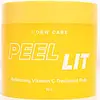What's inside
What's inside
 Key Ingredients
Key Ingredients

 Benefits
Benefits

 Concerns
Concerns

 Ingredients Side-by-side
Ingredients Side-by-side

Water
Skin ConditioningPentylene Glycol
Skin ConditioningGlycolic Acid
BufferingAzelaic Acid
BufferingGlycereth-7 Triacetate
EmollientAlcohol Denat.
AntimicrobialSodium Hydroxide
BufferingPolysorbate 20
EmulsifyingGlycereth-18 Ethylhexanoate
Skin ConditioningDimethyl Isosorbide
SolventDipropylene Glycol
HumectantTranexamic Acid
AstringentCapryloyl Salicylic Acid
ExfoliatingGluconolactone
Skin ConditioningSalix Alba Bark Extract
AstringentMyristyl Nicotinate
Skin ConditioningCitrus Paradisi Fruit Extract
Skin ConditioningCitrus Grandis Peel Oil
MaskingSpiraea Ulmaria Extract
AstringentHydroxymethoxyphenyl Decanone
Skin ConditioningAsiatic Acid
Skin ConditioningMadecassic Acid
Skin ConditioningAdenosine
Skin ConditioningAsiaticoside
AntioxidantEthoxydiglycol
HumectantLactobacillus Ferment
Skin ConditioningGlycerin
HumectantButylene Glycol
HumectantPropanediol
SolventGlycereth-18
HumectantEthylhexylglycerin
Skin ConditioningCalcium Gluconate
HumectantT-Butyl Alcohol
PerfumingCitric Acid
BufferingLimonene
PerfumingSodium Carbonate
BufferingDenatonium Benzoate
MaskingSodium Chloride
MaskingPotassium Sorbate
PreservativeSodium Benzoate
MaskingWater, Pentylene Glycol, Glycolic Acid, Azelaic Acid, Glycereth-7 Triacetate, Alcohol Denat., Sodium Hydroxide, Polysorbate 20, Glycereth-18 Ethylhexanoate, Dimethyl Isosorbide, Dipropylene Glycol, Tranexamic Acid, Capryloyl Salicylic Acid, Gluconolactone, Salix Alba Bark Extract, Myristyl Nicotinate, Citrus Paradisi Fruit Extract, Citrus Grandis Peel Oil, Spiraea Ulmaria Extract, Hydroxymethoxyphenyl Decanone, Asiatic Acid, Madecassic Acid, Adenosine, Asiaticoside, Ethoxydiglycol, Lactobacillus Ferment, Glycerin, Butylene Glycol, Propanediol, Glycereth-18, Ethylhexylglycerin, Calcium Gluconate, T-Butyl Alcohol, Citric Acid, Limonene, Sodium Carbonate, Denatonium Benzoate, Sodium Chloride, Potassium Sorbate, Sodium Benzoate
Water
Skin ConditioningDipropylene Glycol
HumectantNiacinamide
SmoothingSodium Lactate
BufferingMethylpropanediol
SolventBetaine
HumectantCitric Acid
BufferingLactic Acid
BufferingGluconolactone
Skin ConditioningAlthaea Rosea Flower Extract
Skin ConditioningAnanas Sativus Fruit Extract
Skin ConditioningAscorbic Acid
AntioxidantBromelain
Skin ConditioningHydroxyacetophenone
AntioxidantPEG-40 Hydrogenated Castor Oil
EmulsifyingAllantoin
Skin ConditioningCaffeine
Skin ConditioningButylene Glycol
HumectantSaccharide Isomerate
HumectantCaprylyl Glycol
EmollientEthylhexylglycerin
Skin Conditioning1,2-Hexanediol
Skin ConditioningDipotassium Glycyrrhizate
HumectantParfum
MaskingDisodium EDTA
Sodium Citrate
BufferingWater, Dipropylene Glycol, Niacinamide, Sodium Lactate, Methylpropanediol, Betaine, Citric Acid, Lactic Acid, Gluconolactone, Althaea Rosea Flower Extract, Ananas Sativus Fruit Extract, Ascorbic Acid, Bromelain, Hydroxyacetophenone, PEG-40 Hydrogenated Castor Oil, Allantoin, Caffeine, Butylene Glycol, Saccharide Isomerate, Caprylyl Glycol, Ethylhexylglycerin, 1,2-Hexanediol, Dipotassium Glycyrrhizate, Parfum, Disodium EDTA, Sodium Citrate
Ingredients Explained
These ingredients are found in both products.
Ingredients higher up in an ingredient list are typically present in a larger amount.
Butylene Glycol (or BG) is used within cosmetic products for a few different reasons:
Overall, Butylene Glycol is a safe and well-rounded ingredient that works well with other ingredients.
Though this ingredient works well with most skin types, some people with sensitive skin may experience a reaction such as allergic rashes, closed comedones, or itchiness.
Learn more about Butylene GlycolCitric Acid is an alpha hydroxy acid (AHA) naturally found in citrus fruits like oranges, lemons, and limes.
Like other AHAs, citric acid can exfoliate skin by breaking down the bonds that hold dead skin cells together. This helps reveal smoother and brighter skin underneath.
However, this exfoliating effect only happens at high concentrations (20%) which can be hard to find in cosmetic products.
Due to this, citric acid is usually included in small amounts as a pH adjuster. This helps keep products slightly more acidic and compatible with skin's natural pH.
In skincare formulas, citric acid can:
While it can provide some skin benefits, research shows lactic acid and glycolic acid are generally more effective and less irritating exfoliants.
Most citric acid used in skincare today is made by fermenting sugars (usually from molasses). This synthetic version is identical to the natural citrus form but easier to stabilize and use in formulations.
Read more about some other popular AHA's here:
Learn more about Citric AcidDipropylene Glycol is a synthetically created humectant, stabilizer, and solvent.
This ingredient helps:
Dipropylene glycol is technically an alcohol, but it belongs to the glycol family (often considered part of the ‘good’ alcohols). This means it is hydrating and gentle on skin unlike drying solvent alcohols like denatured alcohol.
As a masking agent, Dipropylene Glycol can be used to cover the smell of other ingredients. However, it does not have a scent.
Studies show Dipropylene Glycol is considered safe to use in skincare.
Learn more about Dipropylene GlycolEthylhexylglycerin (we can't pronounce this either) is commonly used as a preservative and skin softener. It is derived from glyceryl.
You might see Ethylhexylglycerin often paired with other preservatives such as phenoxyethanol. Ethylhexylglycerin has been found to increase the effectiveness of these other preservatives.
Gluconolactone is a PHA. PHAs are a great gentle alternative to traditional AHAs.
When applied, Gluconolactone has the same affect on skin as AHAs such as lactic acid. It helps dissolve the dead skin cells in the top layer of your skin. This improves texture and brightens the skin.
PHAs are more gentle than AHAs due to their larger structure. They do not penetrate as deeply as AHAs and take a longer time to dissolve dead cells. Studies show PHAs do not cause as much irritation.
Gluconolactone has some interesting properties:
In a 2004 study, Gluconolactone was found to prevent UV damage in mouse skin cells and has not been found to increase sun sensitivity. However, we still recommend wearing SPF daily.
This ingredient is is an created by reacting gluconic acid with an alcohol.
Learn more about GluconolactoneWater. It's the most common cosmetic ingredient of all. You'll usually see it at the top of ingredient lists, meaning that it makes up the largest part of the product.
So why is it so popular? Water most often acts as a solvent - this means that it helps dissolve other ingredients into the formulation.
You'll also recognize water as that liquid we all need to stay alive. If you see this, drink a glass of water. Stay hydrated!
Learn more about Water